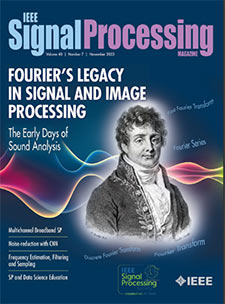- Our Story
- Publications & Resources
- Publications & Resources
- Publications
- IEEE Signal Processing Magazine
- IEEE Journal of Selected Topics in Signal Processing
- IEEE Signal Processing Letters
- IEEE/ACM Transactions on Audio Speech and Language Processing
- IEEE Transactions on Computational Imaging
- IEEE Transactions on Image Processing
- IEEE Transactions on Information Forensics and Security
- IEEE Transactions on Multimedia
- IEEE Transactions on Signal and Information Processing over Networks
- IEEE Transactions on Signal Processing
- IEEE TCI
- IEEE TSIPN
- Data & Challenges
- Submit Manuscript
- Guidelines
- Information for Authors
- Special Issue Deadlines
- Overview Articles
- Top Accessed Articles
- SPS Newsletter
- SigPort
- SPS Resource Center
- Publications Feedback
- Publications FAQ
- Blog
- News
- Dataset Papers
- Conferences & Events
- Community & Involvement
- Professional Development
- For Volunteers
- Information for Authors-OJSP
-
Home
Conferences14 April 2025 to 17 April 2025Conferences Events IEEE JSTSP Article IEEE Signal Processing Magazine IEEE TIFS Article IEEE TMM Article IEEE TSP Article Jobs in Signal Processing Lectures Machine Learning Seasonal Schools Signal Processing News SPM Article SPS Distinguished Lectures SPS Newsletter Article SPS Webinar SPS Webinars SPS Webinar Series Webinar webinars
-
Our Story
What is Signal Processing?

The technology we use, and even rely on, in our everyday lives –computers, radios, video, cell phones – is enabled by signal processing. Learn More » -
Publications & Resources
-
SPS Resources
- Signal Processing Magazine The premier publication of the society.
- SPS Newsletter Monthly updates in Signal Processing
- SPS Resource Center Online library of tutorials, lectures, and presentations.
- SigPort Online repository for reports, papers, and more.
- SPS Feed The latest news, events, and more from the world of Signal Processing.
-
SPS Resources
-
Conferences & Events
-
Community & Involvement
-
Membership
- Join SPS The IEEE Signal Processing Magazine, Conference, Discounts, Awards, Collaborations, and more!
- Chapter Locator Find your local chapter and connect with fellow industry professionals, academics and students
- Women in Signal Processing Networking and engagement opportunities for women across signal processing disciplines
- Students Scholarships, conference discounts, travel grants, SP Cup, VIP Cup, 5-MICC
- Young Professionals Career development opportunities, networking
- Get Involved
-
Technical Committees
- Applied Signal Processing Systems
- Audio and Acoustic Signal Processing
- Bio Imaging and Signal Processing
- Computational Imaging
- Image Video and Multidimensional Signal Processing
- Information Forensics and Security
- Machine Learning for Signal Processing
- Multimedia Signal Processing
- Sensor Array and Multichannel
- Signal Processing for Communication and Networking
- Signal Processing Theory and Methods
- Speech and Language Processing
- Technical Working Groups
- More TC Resources
-
Membership
-
Professional Development
-
Professional Development
- Mentoring Experiences for Underrepresented Young Researchers (ME-UYR)
- Micro Mentoring Experience Program (MiME)
- Distinguished Lecturer Program
- Distinguished Lecturers
- Distinguished Lecturer Nominations
- Past Lecturers
- Distinguished Industry Speaker Program
- Distinguished Industry Speakers
- Distinguished Industry Speaker Nominations
- Industry Resources
- IEEE Training Materials
- Jobs in Signal Processing: IEEE Job Site
-
Career Resources
- SPS Education Program Educational content in signal processing and related fields.
- Distinguished Lecturer Program Chapters have access to educators and authors in the fields of Signal Processing
- PROGRESS Initiative Promoting diversity in the field of signal processing.
- Job Opportunities Signal Processing and Technical Committee specific job opportunities
- Job Submission Form Employers may submit opportunities in the area of Signal Processing.
-
Professional Development
-
For Volunteers
-
For Board & Committee Members
- Board Agenda/Minutes* Agendas, minutes and supporting documentation for Board and Committee Members
- SPS Directory* Directory of volunteers, society and division directory for Board and Committee Members.
- Membership Development Reports* Insight into the Society’s month-over-month and year-over-year growths and declines for Board and Committee Members
-
For Board & Committee Members
Popular Pages
Today's:
- Submit a Manuscript
- Information for Authors
- IEEE/ACM Transactions on Audio Speech and Language Processing
- IEEE Transactions on Multimedia
- IEEE Transactions on Image Processing
- (MLSP 2024) 2024 IEEE International Workshop on Machine Learning for Signal Processing
- (SLT 2024) 2024 IEEE Spoken Language Technology Workshop
- Information for Authors-SPL
- IEEE Transactions on Signal Processing
- IEEE Signal Processing Letters
- Award Recipients
- (ACSSC 2024) 2024 Asilomar Conference on Signals, Systems, and Computers
- Governance Documents
- (ICASSP 2024) 2024 IEEE International Conference on Acoustics, Speech and Signal Processing
- IEEE Journal of Selected Topics in Signal Processing
All time:
- Information for Authors
- Submit a Manuscript
- IEEE Transactions on Image Processing
- 404 Page
- IEEE/ACM Transactions on Audio Speech and Language Processing
- IEEE Transactions on Information Forensics and Security
- IEEE Transactions on Multimedia
- IEEE Signal Processing Letters
- IEEE Transactions on Signal Processing
- Conferences & Events
- IEEE Journal of Selected Topics in Signal Processing
- Information for Authors-SPL
- Conference Call for Papers
- Signal Processing 101
- IEEE Signal Processing Magazine
Last viewed:
- Call for Proposals: IEEE ASRU 2025
- Guidelines
- IEEE Transactions on Information Forensics and Security
- (ICASSP 2024) 2024 IEEE International Conference on Acoustics, Speech and Signal Processing
- (ACSSC 2024) 2024 Asilomar Conference on Signals, Systems, and Computers
- Governance Documents
- Editorial Board
- Manuscript Submission Guidelines SP Magazine Feature Special Issue Articles
- Conferences & Events
- Janusz Konrad
- Overview Articles
- Submit a Manuscript
- Information for Authors OJSP
- 4D Automotive Radar Sensing for Autonomous Vehicles: A Sparsity-Oriented Approach
- (SLT 2024) 2024 IEEE Spoken Language Technology Workshop
Biometrics Security and Privacy Protection: IEEE Signal Processing Magazine, September 2015
You are here
Newsletter Menu
Newsletter Categories
Top Reasons to Join SPS Today!
1. IEEE Signal Processing Magazine
2. Signal Processing Digital Library*
3. Inside Signal Processing Newsletter
4. SPS Resource Center
5. Career advancement & recognition
6. Discounts on conferences and publications
7. Professional networking
8. Communities for students, young professionals, and women
9. Volunteer opportunities
10. Coming soon! PDH/CEU credits
Click here to learn more.
News and Resources for Members of the IEEE Signal Processing Society
Biometrics Security and Privacy Protection: IEEE Signal Processing Magazine, September 2015
(Excerpt from the guest editorial of the September 2015 Signal Processing Magazine)
Biometrics is the science of recognizing individuals based on their behavioral and biological characteristics such as face, fingerprints, iris, voice, gait, and signature. A typical biometric system may be viewed as a pattern classification system that utilizes advanced signal processing schemes to compare and match biometric data.
Since an individual's biometric data is personal and sensitive, issues related to biometric security and privacy have been raised. The advent of cloud computing technology and personal mobile devices has broadened the application domain of biometrics; however, at the same time, it has brought to the forefront the need for dedicated security technologies to protect biometric data from being misappropriated and used for purposes beyond those intended. Similarly, the use of surveillance systems in public areas presents new challenges with respect to privacy.
The special issue of IEEE Signal Processing Magazine, Sep. 2015, was conceived to champion recent developments in the rapidly evolving field and also to encourage research in new signal processing solutions to security and privacy protection.
The first contribution from Hadid, Evans, Marcel, and Fierrez focuses on the security side of biometrics, providing a gentle introduction to spoofing and countermeasures and a methodology for their assessment. The article also provides a case study in face recognition.
The next contribution discusses how adversarial machine-learning techniques can be harnessed to protect biometric systems from sophisticated attacks. Biggio, Fumera, Russu, Didaci, and Roli argue that security is best delivered with adaptive, security-by-design solutions.
Itkis, Chandar, Fuller, Campbell, and Cunningham report the challenges in designing effective cryptosystems for iris-recognition systems. Their work also illustrates the shortcoming of the more traditional performance metrics used in biometrics and promotes the use of a new entropy metric.
The article by Patel, Ratha, and Chellappa reviews different approaches to cancelable biometric schemes for template protection. The aim of such techniques is to preserve privacy by preventing the theft of biometric templates through the application of noninvertible transforms.
Barni, Droandi, and Lazzeretti describe a different approach to template protection based on cryptographic technology. They illustrate how secure, two-party computation and signal processing in the encrypted domain can be combined to enhance security and protect privacy.
Still on the theme of template protection, Lim, Teoh, and Kim describe their work on biometric feature-type transformation. Such transformations are typically used as a precursor to many forms of biometric cryptosystems that demand specific input formats such as point-set or binary features.
The final article on template protection discusses the practical implications of biometric security and offers a fresh perspective to the problem. Nandakumar and Jain argue that improvements to security and privacy seldom come without degradations to recognition performance and that, consequently, there remains a significant gap between theory and practice.
The special section rounds out with an article by Bustard on the privacy and legal concerns surrounding the collection, storage, and use of personal biometric data. In particular, the article discusses recent European legislation on this issue and its potential impact on the adoption of biometrics technology.
Reference:
Nicholas Evans, Sébastien Marcel, Arun Ross, Andrew Beng Jin Teoh. Biometrics Security and Privacy Protection. IEEE Signal Processing Magazine. 2015, Sep. 17-18
Open Calls
Research Opportunities
News & Announcements
- Signal Processing Conferences
- Call for Participation: IEEE Signal Processing Cup 2016
- Obituary for James L. Flanagan
- Call for Papers: ICASSP 2016
- IEEE-USA offers free e-books to members in August and September
- Get involved in IEEE Future Directions initiatives; contribute IoT use case scenarios
- 2015 Member-Driven Initiatives – Funding Available
- vTools release announcement: Usability and interface enhancements
- Request for proposals: Humanitarian projects: deadline 30 September
- Geographic unit website feature: Automatic feed of officers and events available
- IEEE in 2030 Challenge seeks proposals for innovative projects: Deadline extended to 15 September
- Member Discounts: International travel guide for members in Regions 8-10
- IEEE Women in Engineering news: Live chat series, 2016 leadership conference, virtual career fair, awards program, summits
- New SPS Chapters
- Use vTools.Voting for your upcoming unit elections
- Updated call for participation: 2015 Volunteer Leadership Training Program (VOLT): Deadlines 24 August and 4 September
- Last call for applications: IEEE Smart Cities Initiative: Deadline extended to 31 August
Member Highlights
Society News
Initiatives & Trends
Education & Resources
PhD Theses
Chapter & DL News
SPS on Twitter
- DEADLINE EXTENDED: The 2023 IEEE International Workshop on Machine Learning for Signal Processing is now accepting… https://t.co/NLH2u19a3y
- ONE MONTH OUT! We are celebrating the inaugural SPS Day on 2 June, honoring the date the Society was established in… https://t.co/V6Z3wKGK1O
- The new SPS Scholarship Program welcomes applications from students interested in pursuing signal processing educat… https://t.co/0aYPMDSWDj
- CALL FOR PAPERS: The IEEE Journal of Selected Topics in Signal Processing is now seeking submissions for a Special… https://t.co/NPCGrSjQbh
- Test your knowledge of signal processing history with our April trivia! Our 75th anniversary celebration continues:… https://t.co/4xal7voFER
Home | Sitemap | Contact | Accessibility | Nondiscrimination Policy | IEEE Ethics Reporting | IEEE Privacy Policy | Terms | Feedback
© Copyright 2024 IEEE – All rights reserved. Use of this website signifies your agreement to the IEEE Terms and Conditions.
A not-for-profit organization, IEEE is the world's largest technical professional organization dedicated to advancing technology for the benefit of humanity.








